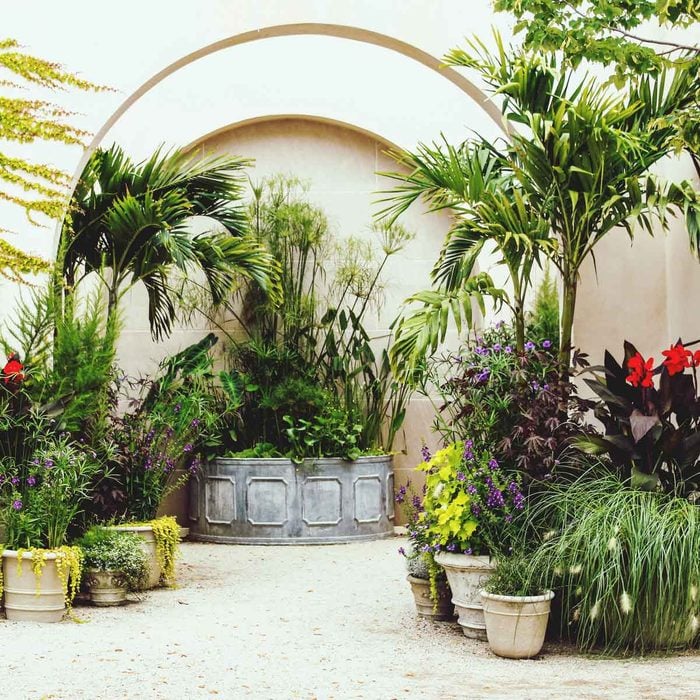ZAMBEZISHARK/GETTY IMAGES
ZAMBEZISHARK/GETTY IMAGES
Pros:
-
Bright, blue and purple flowers
-
Thrives indoors or outdoors
-
Can be grown in most types of soil
-
Low maintenance
Cons:
-
Can grow up to 40 feet tall
Anyone who’s ever been enchanted by the large jacaranda trees lining California boulevards will never forget the sight. These large, showy deep-purple blooms are also available on dwarf plants, such as Bonsai Blue (Jacaranda mimosifolia ‘Sakai01’). While a landscape jacaranda tree can reach 50 feet, Bonsai Blue is just 10 to 12 feet tall. Although it grows fast, you can keep it shorter because the attractive fernlike foliage takes pruning in stride. It’s also drought tolerant — a definite plus when it comes to container plants. Bonsai Blue jacaranda is hardy in USDA zones 9 to 11.
How to Grow a Tree in a Pot
It’s easy to grow a tree in a container if you follow a few simple steps.
- Select a dwarf variety (they’re better suited to containers and won’t require as much pruning) or a tree form shrub, which is pruned into a single trunk.
- Use a large container. It aids tree growth, allowing for a bigger root mass that better withstands erratic watering.
- Fill the container with a potting mix containing moisture-retentive crystals to capture more irrigation water.
- Water regularly. A pot-grown tree needs more frequent watering than one planted in the ground.
- Winter protection is needed in cold climates. Store dormant deciduous trees in an attached garage, keeping the rootball slightly moist. Return it outdoors in spring. Evergreens still need light in winter, so it’s best to “heel in” a potted evergreen unless the garage has a window. This means temporarily burying the tree’s roots in the ground for the winter and mulching heavily. Return the tree to its pot in spring.
ⓘ
What To Look For When Shopping For Trees To Grow In a Pot
You may think of trees as plants that grow strictly in the ground, but several varieties of trees can grow and thrive in pots. Consider slow-growing and adaptable varieties when searching for a tree to grow in a pot. Fast-growing trees might thrive, but they’d need to be repotted often, which, though doable, requires more maintenance than slow-growing varieties. Consider the weather conditions in your area and choose a tree that is well-suited to your climate. For example, some trees may not fare as well in very hot weather, whereas others may not thrive in the cold. Furthermore, choose one that draws your eye visually. Trees grow to be large, so choosing one that you find beautiful and complements your yard or home is important.
Why You Should Trust Us
Luke Miller is a garden editor with over 25 years of experience in horticultural communications. Miller has edited a national magazine and created print and online gardening content for a national retailer. Additionally, he is a Master Gardener and has extensively studied horticulture.
Nina Derwin is a commerce updates editor for Family Handyman. She has experience researching and reviewing various items to help shoppers find the best products on the market. She researched and updated this piece.
How We Found the Best Trees to Grow In a Pot
When considering the best trees to grow in a pot, we first considered size. We searched for sturdy varieties that can withstand all types of weather conditions, including hot sun and chilly winter temperatures. We also paid close attention to the appearance of different types of trees and their aesthetic qualities, both indoors and outdoors.
FAQ
Can trees survive in pots?
When watered and properly fertilized, potted trees can survive for many years. Be sure to use a large enough container to allow the tree room to grow. You may need to transfer it to a larger container over time.
What size pot do I need for a five foot tree?
Generally, a five-gallon container is the correct size for a four- to five-foot tree. The dimensions should be approximately 12 inches by 12 inches. For a five- to seven-foot tree, consider using a seven-gallon or 14-inch by 14-inch container.
How deep should I plant a tree in a pot?
When digging a hole in soil to plant a tree in a pot, the hole should not be deeper than the tree’s root ball. It’s important that the root ball rests on the soil in the center of the container.
ⓘ





























